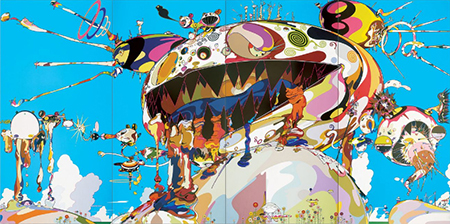
Continuing through September 24, 2017
Since the days of his “Superflat" anime-inspired imagery Takashi Murakami has been a fixture in the public eye. His signature smiling daisies, commercial collaborations with Kanye West and Louis Vuitton have helped to keep him there. However, for both art world regulars and the general audience, “Takashi Murakami: The Octopus Eats Its Own Leg” is a true education in the rich practice of this contemporary master. Murakami fuses high and low culture, the new and the ancient into his brand. His is indeed a brand in the true sense of the word, though this major retrospective also reveals that such a machine can also be a vehicle for abundant meaning.
The exhibition opens with Murakami’s early works. Pieces from the late 1980s and early 1990s are in a variety of media and styles, unrecognizable from the work we’re accustomed to seeing. He plays off of Anselm Kiefer’s dramatic palette and perspective, Mark Rothko’s luminous fields of color, On Kawara’s reductivism. While the youthful emulation and/or critique of these canonical styles ends abruptly with the appearance of of Murakami’s manga cartoon style in the adjacent room, “The Octopus Eats Its Own Leg” is peppered with the underlying sentiments that these very early works embody.
Selections from the early 1990s include Murakami’s first works with Mr. DOB, the artist’s branded mouse character who evolves throughout his oeuvre. There are only a few examples at this stage: the mouse on a tshirt, or painted on modestly sized canvases. The shift toward commissioning commercial painters to precisely render the graphic imagery begins in the mid-1990s, and from there, the exhibition detours.
Another gallery introduces us to Murakami’s studio team, who mix paint, silkscreen, assemble panels and otherwise implement the labor-intensive processes under the artist’s direction, which leads to epic, exceptionally detailed paintings and sculptures. Despite the dependence on so many hands, this facet of Murakami’s practice does not diminish their aura. The rigorous studio machine reinforces the grandeur of his works even as they explain how these works become so larger-than-life.
“The Octopus Eats Its Own Leg” includes plenty of Murakami’ sleekest, pop cultural production: the Kanye collaborations, the colorful mushrooms, and the grinning daisies. The most resonate works are those which appear to be at odds with mass appeal. In "Tan Tan Bo Puking - aka Gero Tan" (2002), the monstrous painting depicts a barely recognizable Mr. DOB oozing from a sharp-toothed, cavernous mouth as other small, floating creatures incite chaos around him. The horizon is very low in this picture, running along the bottom of the scene, and featuring a small cluster of his tiny, smiling daisies oblivious to the technicolor turmoil in the sky above them. The scene is unsettling and fantastical, the mouse’s colorful bile flowing like rivers of paint. After seeing how the young Murakami took jabs at the canon, we feel the dig here at the practice of painterly abstraction.
Murakami dispenses with his graphic, branded figures in the mid-to-late 2000s in favor of “the pursuit of timelessness,” opting for historical imagery like dragons, lions and monks. And, while his rendering is still the epitome of control, graphic sleekness is supplanted by planned imperfection. Drips of paint and shifted outlines are visible in "Of Chinese Lions, Peonies, Skulls, and Fountains" (2011), and "Dragon in Clouds - Indigo Blue" (2010) which is actually hand painted. The blue, monochromatic palette harkens to the lapiz lazuli of Murakami’s early Rothko-esque work from 1989.
A pair of long, jam-packed paintings unfurl like scrolls, "100 Arhats" and "69 Arhats Beneath the Bodhi Tree" (both 2013). Craggy monks, varying from outsized to life-sized to miniature, are compounded with creatures, patterns and symbols. Murakami now freely embraces and intermixes folk, art historical and vernacular visual languages, manifesting them in his own unnerving, kaleidoscopic style. These incredibly rich, strange and detailed scenes are the opposite of the simplicity of the “Hello Kitty”-style motifs of his early inspiration. A lifetime spent looking at Murakami’s extraordinary, mythical narratives would continuously reveal new and different reads and interpretations.
